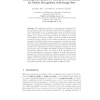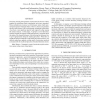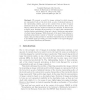64 search results - page 5 / 13 » On the Benefits of Representing Music Objects as Fuzzy Sets |
ECCV
2006
Springer
14 years 9 months ago
2006
Springer
Abstract. We address the problem of comparing sets of images for object recognition, where the sets may represent arbitrary variations in an object's appearance due to changin...
ICMLA
2009
13 years 5 months ago
2009
Chord sequences are a compact and useful description of music, representing each beat or measure in terms of a likely distribution over individual notes without specifying the not...
ARTMED
2010
13 years 7 months ago
2010
Objective: The programming language Arden Syntax has been optimised for use in clinical decision support systems. We describe an extension of this language named Fuzzy Arden Synta...
ICASSP
2010
IEEE
13 years 7 months ago
2010
IEEE
Dictionary learning through matrix factorization has become widely popular for performing music transcription and source separation. These methods learn a concise set of dictionar...
ICIAP
1997
ACM
13 years 11 months ago
1997
ACM
We present a model for image retrieval in which images are represented both at the form level, as sets of physical features of the representing objects, and at the content level, a...



